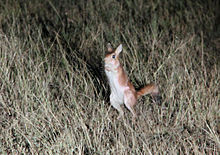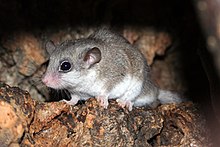Rodent
Rodents (from Latin rodere, 'to gnaw') are mammals of the order Rodentia (/roʊˈdɛnʃə/ roh-DEN-shə), which are characterized by a single pair of continuously growing incisors in each of the upper and lower jaws.[9] The cheek pouch is a specific morphological feature used for storing food and is evident in particular subgroups of rodents like kangaroo rats, hamsters, chipmunks and gophers which have two bags that may range from the mouth to the front of the shoulders.Some species such as tree squirrels and New World porcupines are arboreal, while some, such as gophers, tuco-tucos, and mole rats, live almost completely underground, where they build complex burrow systems.They maintain these grassland habitats,[23] and some large herbivores such as bison and pronghorn prefer to graze near prairie dog colonies due to the increased nutritional quality of forage.They store food for winter use by felling small trees and leafy branches in the autumn and immersing them in their pond, sticking the ends into the mud to anchor them.Cooperation in ground squirrels varies between species and typically includes making alarm calls, defending territories, sharing food, protecting nesting areas, and preventing infanticide.In non-kin communication, where more permanent odor markers are required, as at territorial borders, then non-volatile major urinary proteins (MUPs), which function as pheromone transporters, may also be used.[55] Similarly, the common degu, another social, burrowing rodent, exhibits a wide array of communication methods and has an elaborate vocal repertoire comprising fifteen different categories of sound.In clinical studies, the chirping is associated with positive emotional feelings, and social bonding occurs with the tickler, resulting in the rats becoming conditioned to seek the tickling.[62] However, the amount of UV that is reflected decreases with time, which in some circumstances can be disadvantageous; the common kestrel can distinguish between old and fresh rodent trails and has greater success hunting over more recently marked routes.Several reasons have been proposed for this behavior, including nutritional stress, resource competition, avoiding misdirecting parental care and, in the case of males, attempting to make the mother sexually receptive.[76] To protect against infanticide from other adults, female rodents may employ avoidance or direct aggression against potential perpetrators, multiple mating, territoriality or early termination of pregnancy.[87][88] Dentition is the key feature by which fossil rodents are recognized and the earliest record of such mammals comes from the Paleocene, shortly after the extinction of the non-avian dinosaurs some 66 million years ago.[93][94] Rodents are thought to have evolved in Asia, where local multituberculate faunas were severely affected by the Cretaceous–Paleogene extinction event and never fully recovered, unlike their North American and European relatives.[103] Some fossil species were very large in comparison to modern rodents and included the giant beaver, Castoroides ohioensis, which grew to a length of 2.5 m (8 ft 2 in) and weight of 100 kg (220 lb).The earliest fossil rodents in Australia have a maximum age of 4.5 million years,[107] and molecular data is consistent with the colonization of New Guinea from the west during the late Miocene or early Pliocene followed by rapid diversification.[108] Rodents participated in the Great American Interchange that resulted from the joining of the Americas by formation of the Isthmus of Panama, around 3 million years ago in the Piacenzian age.[117] Gliridae Aplodontidae Sciuridae Ctenodactylidae Diatomyidae Hystricidae Bathyergidae Petromuridae Thryonomyidae Erethizontidae Cuniculidae Caviidae Dasyproctidae Dinomyidae Chinchillidae Abrocomidae Echimyidae Ctenomyidae Octodontidae Castoridae Heteromyidae Geomyidae Anomaluridae Pedetidae Dipodidae Platacanthomyidae Spalacidae Calomyscidae Nesomyidae Cricetidae Muridae The order Rodentia may be divided into suborders, infraorders, superfamilies and families.This parallel evolution includes not only the structure of the teeth, but also the infraorbital region of the skull (below the eye socket) and makes classification difficult as similar traits may not be due to common ancestry.Schlosser (1884) performed a comprehensive review of rodent fossils, mainly using the cheek teeth, and found that they fitted into the classical system, but Tullborg (1899) proposed just two sub-orders, Sciurognathi and Hystricognathi.These disagreements remain unresolved, nor have molecular studies fully resolved the situation though they have confirmed the monophyly of the group and that the clade has descended from a common Paleocene ancestor.[125] The IUCN Species Survival Commission writes "We can safely conclude that many South American rodents are seriously threatened, mainly by environmental disturbance and intensive hunting".[127] This approach has been successful on the island of Lundy in the United Kingdom, where the eradication of an estimated 40,000 brown rats is giving populations of Manx shearwater and Atlantic puffin a chance to recover from near-extinction.The Bramble Cay melomys, which lived in the northernmost point of land of Australia, was the first mammal species to be declared extinct as a consequence of human-caused climate change.[142] Guinea pigs played a major role in the establishment of germ theory in the late 19th century, through the experiments of Louis Pasteur, Émile Roux, and Robert Koch.[150][151][152] Rodents including guinea pigs,[153] mice, rats, hamsters, gerbils, chinchillas, degus and chipmunks make convenient pets able to live in small spaces, each species with its own qualities.In Asia, rats, mice and species such as Microtus brandti, Meriones unguiculatus and Eospalax baileyi damage crops of rice, sorghum, tubers, vegetables and nuts.In Europe, as well as rats and mice, species of Apodemus, Microtus and in occasional outbreaks Arvicola terrestris cause damage to orchards, vegetables and pasture as well as cereals.In South America, a wider range of rodent species, such as Holochilus, Akodon, Calomys, Oligoryzomys, Phyllotis, Sigmodon and Zygodontomys, damage many crops including sugar cane, fruits, vegetables, and tubers.Interventions may include education, making and applying laws and regulations, modifying the habitat, changing farming practices, and biological control using pathogens or predators, as well as poisoning and trapping.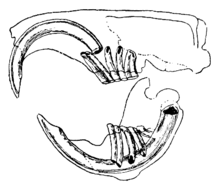




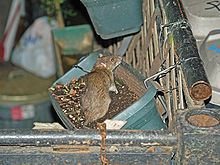




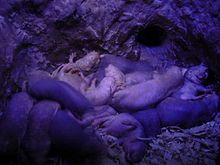















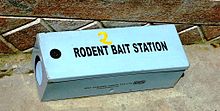
Late PaleocenePreꞒCapybaraSpringhareGolden-mantled ground squirrelNorth American beaverHouse mouseScientific classificationEukaryotaAnimaliaChordataMammaliaSimplicidentataBowdichAnomaluromorphaCastorimorphaHystricomorphaCaviomorphaMyomorphaSciuromorphamammalsincisorslower jawsAntarcticaarborealfossorialsaltatorialsquirrelsprairie dogsporcupinesbeaversguinea pigshamstersrabbitsLagomorphasister groupssingle common ancestorGliresmonogamypolygynylittersaltricialprecocialfossilPaleoceneLaurasiaEocenecrossing oceansplacental mammalslaboratory animalsbrown ratblack ratintroduced speciesinvasiveenameldentinediastemaguinea pigchiselpremolarsmassetereastern grey squirreltemporalischeek pouchkangaroo ratsplantigradequadrupedalbipedalhopping miceScaly-tailed squirrelsflying squirrelsparachute-like membranesagoutiantelopedigitigradeprehensileEurasian harvest mouseChinchillaultravioletwhiskers"whisking"cheek pouchescellulosecarbohydratecoprophagybaculumSexual dimorphismground squirrelsmole ratspocket gopherssexual selectionchipmunksjumping miceyellow-pine chipmunksbank volesNew GuineaPolynesian rattundratree squirrelsNew World porcupinesgopherstuco-tucosmuskratsearless water ratagriculturalurban areasecosystem engineerskeystone speciesGreat Plainsaerationpronghornbiodiversity losssporessymbiotic relationshipshydrologicalherbaceous plantriparian areasEastern chipmunkherbivorousomnivorousfield voleplains pocket gophercachesTexas pocket gopherAfrican pouched ratBrazil nut
